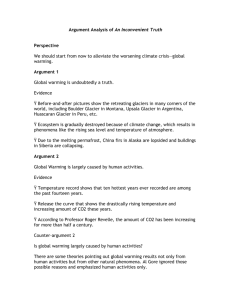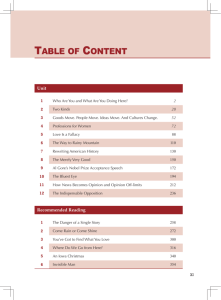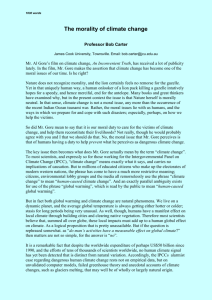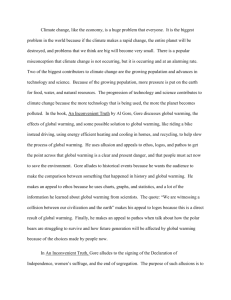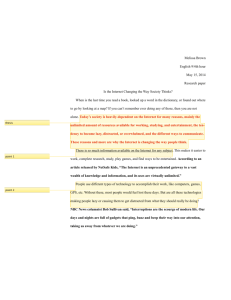English 1020- Project 2 - lauriebonventrewinterenglish1020
advertisement
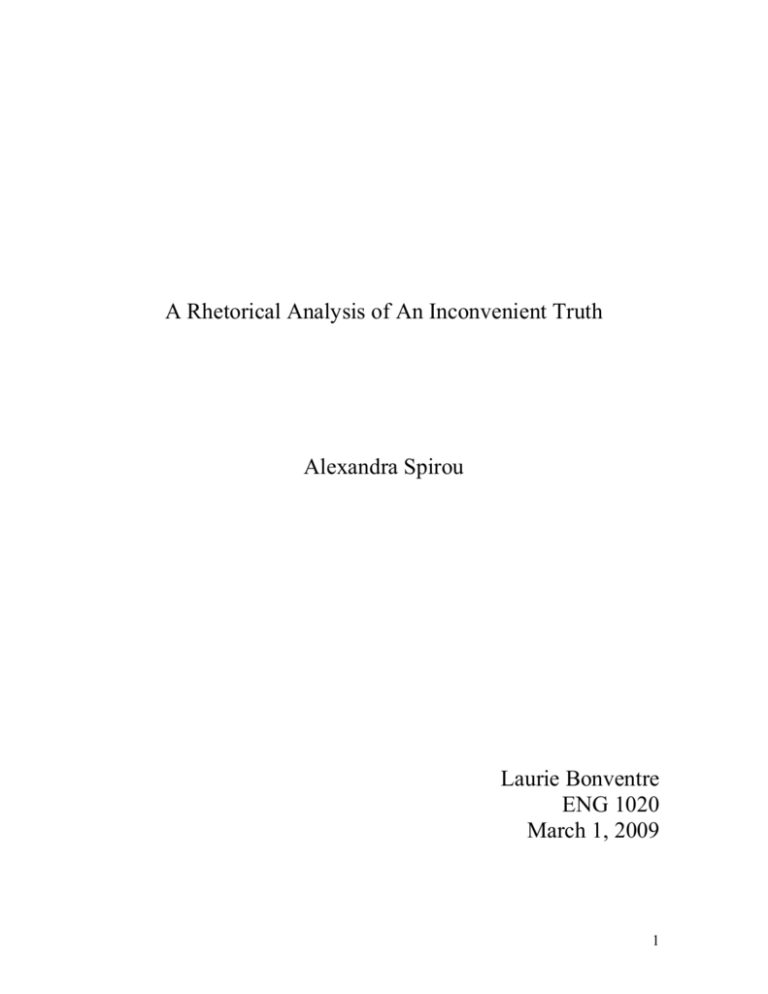
A Rhetorical Analysis of An Inconvenient Truth Alexandra Spirou Laurie Bonventre ENG 1020 March 1, 2009 1 Global warming is the most terrifying issue that we face today. The gradual warming of the earth, due to excess carbon dioxide from the sun’s heat, is the central concern of Al Gore’s book An Inconvenient Truth. Al Gore, a former vice president of the United States, wrote An Inconvenient Truth as well as starred in a documentary with the same title in 2006 to raise awareness of global warming and to show what we can do about it. In An Inconvenient Truth Al Gore masterfully incorporates the key elements of rhetoric, logos, pathos, and ethos, to present a compelling scientific and moral argument about global warming which he views as the environmental epidemic of our lifetime. Gore doesn’t simply aim to raise awareness but also to motivate readers to take action, without which he contends, our planet is destined to suffer continued dire consequences. Gore’s main thesis states that global warming is real, potentially catastrophic, and primarily human generated. He skilfully utilizes the element of logos throughout the book infusing his argument with the use of logic. Gore’s book is a user friendly, easily understood introduction to global warming. He argues that global warming is not just a scientific or political issue but a moral one as well. The book provides a succinct summary of many of the main ideas laid out in more scholarly and scientific books and journals. He eloquently summarizes and shares data that supports his main thesis. This includes a study done by one of his university professors, Roger Revelle, conducted from the Mauna Loa Observatory. Revelle measured carbon dioxide and created a keeling curve. The data that Gore presents adds more persuasive power to his central argument. To further underscore the dramatic impact of global warming, Gore presents a series of facts documenting the retreat of glaciers since 1850 and provides the dramatic results of ice core data from Antarctica showing carbon dioxide concentrations higher than 2 at any time during the past 650, 000 years. He also presents a survey of 928 peer-reviewed scientific articles which “for the most part support the human-caused global warming consensus” (Gore 262). His liberal use of facts creates a more compelling argument. His central argument is based on collective scientific evidence that the planet is warming. As the planet warms, Gore maintains it has many terrible consequences such as the melting of the polar ice caps, the “disrupting of millions of delicately balanced ecological relationships among species” (Gore 153) and the warming of oceans. As oceans get warmer, he argues that storms get stronger. Gore explains that warmer oceans increase the moisture content of storms, and warmer air holds more moisture. “When storm conditions trigger a downpour, more of it falls in the form of big, one-time rainfalls and snowfalls. As an example he cites the fact that “in 2004 Florida was hit by four unusually powerful hurricanes” which he contends are directly connected to global warming (Gore 80). The use of the 2004 storms to illustrate his point is a particularly fitting example as it plays on the recent memories of the devastation caused by these horrific hurricanes. Those severe weather events wreaked havoc on thousands of people and caused tens of millions of dollars in property damage. Gore also contends that warming oceans is resulting in “an increase in large flood events decade by decade, on every continent” (Gore 106). Paradoxically, however, Gore points out that global warming “causes not only more flooding but also more drought” (Gore 112). One of the reasons for this paradox has to do with the fact that global warming not only increases precipitation worldwide but at the same time causes some of it to relocate. The use of this paradox serves to further peak the readers’ interest and effectively addresses popular doubts about the existence of global warming. Gore recognizes that it is 3 easy for people to doubt the legitimacy of global warming. He realizes that some people who experience severe snow storms and more severe winter weather are sceptical about global warming. By addressing doubts directly about global warming Gore more effectively advances his argument and makes a stronger case. Pathos is another rhetorical device used by Gore in his book to emotionally connect the audience to the issue being explored. One such element of pathos Gore incorporates in this book is his use of analogy to elicit emotion in his readers. One direct analogy is the story about a classic science experiment involving a frog that jumps into a pot of boiling water and immediately jumps out again because it instantly recognizes the danger. “The same frog, finding itself in a pot of lukewarm water that is being brought to a boil, will simply stay in the water—in spite of the danger—until it is too late” (Gore 254). Gore wants readers to identify themselves with the frog. This frog analogy likens humanity’s plight to the frogs. Instead of a pot of boiling water our survival is threatened by global warming. The use of this analogy creates a sense of identification with the frog’s plight and plays on our fears. Gore maintains that the larger point to the story is that our collective ‘nervous system,’ through which we recognize an impending danger to our survival, is similar to the frog’s. We are experiencing global warming so gradually and slowly we may not recognize the seriousness of the danger we are facing until it is too late to react. He adds that although global warming may seem gradual in the context of a single lifetime, in the context of the Earth’s history it is actually happening with lightning speed. Gore also expertly plays on the audience’s sentimentality through the use of striking visual and graphic elements in the text. He uses visuals effectively to create 4 meaning and elicit emotion from the audience. An example of this is his deliberate use of provocative and often gut wrenching photos of glaciers melting off mountains (Gore 184185), hurricanes pounding cities and coastlines (Gore 94-95), and rising seas swamping suburban streets (Gore 108-109). Through the use of these types of visual images he poignantly paints a drastic picture of the consequences of human negligence on our planet and elicits strong emotional responses of horror and despair from his readers. These graphics and photos tell a far more compelling story than words alone could ever convey. Gore understands that global warming is best understood and most effectively made personal when readers can connect emotionally to this complex scientific issue. He understands that too much text can alienate readers. Gore incorporates vivid images to rally support and persuade readers that each one has a vital personal stake in the fight against global warming. One other particularly effective graphic treatment used in the book is the incorporation of stark black pages with bold white lettering. The black and white pages (Gore 196, 197) emphasize the grim reality of global warming and serve to reinforce the fact that the issue at its core is a clear black and white case. In other words, the stark use of black and white throughout the book implies there is no ‘grey’ when it comes to this issue; we either make certain changes and reduce the impact of global warming, or we are doomed to suffer the catastrophic consequences of our inactions. Gore also presents numerous heart wrenching photos designed to elicit a strong emotional reaction from the reader. The photos he uses depicting the devastation left in the wake of hurricane Katrina are particularly powerful. Gore is banking on readers recent memories of that catastrophic event to bolster the persuasive power of his argument. 5 He further manipulates and plays on our emotions by sharing with the readers the tragic tale of polar bears drowning in droves as they attempt to swim longer and longer distances because of the decreasing availability of solid ice sheets (Gore 147). He also presents photos of the beautiful emperor penguins (Gore 179) and tells the reader that these beloved creatures are facing extinction and may soon disappear from the planet because of the impact of global warming. By sharing the plight of these poor animals Gore effectively pulls on his readers heart strings and plays on our guilt since global warming is primarily human caused. Readers are confronted with the harsh truth: humans are the cause of global warming, and because of it, many beautiful creatures and precious ecosystems are destined for death because of human kind. Gore’s skilful use of pathos throughout the book further supports and strengthens his argument and his effort to inspire his readers to take action. Ethos, the final element of rhetoric evident in this book, is the establishment of credibility and trust in the author. In terms of ethos, Al Gore, as former Vice President of the United States and a long serving politician, has achieved a level of notoriety even before this book was published. His credibility and celebrity status allows him to immediately command the readers’ attention. He leverages that status to captivate his readers’ regardless of their personal political affiliation. As a political figure Gore has already established a high recognition factor but it is through his sharing of personal anecdotes in this book that he truly humanizes himself, and thereby builds trust and makes himself more relatable to his audience. His use of personal anecdotes in his book is also a great tool to connect issues central to the book with the audience. One such anecdote involves his sister and her struggle with lung cancer. Gore described his sister as “luminous, charismatic, gutsy, astute, funny incredibly smart and 6 kind” (Gore 255). They were very close growing up and his sister Nancy started smoking when she was 13 years old. Al first got news of her initial diagnosis of lung cancer in 1983 and she died in 1984. Gore says, “I know from this experience that it sometimes takes time to connect all the dots when accepted habits and behaviors are first found to be harmful. But I also learned that a day of reckoning might come when you very much wish that you had connected the dots more quickly” (Gore 258). Now, of course, just as scientists in 1964 told people that smoking kills people by causing lung cancer and other diseases, the best scientists of the 21st century are telling people even more urgently that global warming is putting the future of human civilization at risk. And Gore asserts that once again, we are taking our time—too much time—in connecting the dots. Gore plays on the audience’s sympathies by sharing his story of his sister’s cancer and what can happen if we don’t heed the warning signs. Another anecdote is about his son, Albert, and his near fatal car accident. Al and his wife had taken their son to the season-opening Orioles game in Baltimore. As they left the stadium, Al’s son’s hand was in his and they stopped at the curb. Suddenly one of Albert’s friends, who was walking just in front of them with his dad, bolted off the sidewalk and took off running as fast as he could across the busy one-way street. Then, in the next instant, with no warning, his son pulled his hand out of his and jumped off the curb running to chase his friend across the street. But before he got to the far lane, he was hit by a speeding car. He “watched what no parent should ever see: His son was knocked into the air with a horrible thud and then hit the pavement 30 feet away from the point of impact, scraping the pavement until he came to rest, motionless and silent” (Gore 68). His son survived and was completely healed within a year. Sharing these anecdotes with the 7 reader helps them to better connect and identify with the author. The whole experience was a turning point for Gore and formed a new outlook on what was really important, including the global environment crisis. Gore tells his readers that, “I truly believe…I have an obligation to pay attention to what matters and to do my part to protect it, and to do whatever I can to make sure that what is most precious about God’s beautiful Earth—its liveability for us, our children, future generations—doesn’t slip from our hands” (Gore 71). These stories that Gore tells humanize him and make him more relatable to his audience. Gore also recognizes that in order to create a compelling argument he must incite fear and anxiety in his readers and he does so through the examples he uses of the environmental consequences of global warming. However, in spite of the discouraging, scientific evidence and growing concern for global warming at the end of his book, Gore offers his readers a sense of hope. He identifies solutions to the global warming crisis that every day people can implement and brings a message of hope which is intended to empower to the reader and inspire change. He maintains that everyone has the power to make a difference. Skilful persuasion relies on a careful balance of logos, pathos and ethos. To empower humankind to make the necessary changes required to solve global warming, Al Gore presents a persuasive scientific and moral case which is masterfully supported through the elements of rhetoric: logos, pathos and ethos. 8 Works Cited Gore, Albert. An Inconvenient Truth. New York, NY: Rodale, 2006 9

